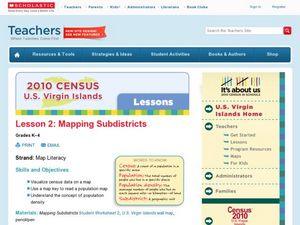Curated OER
Greek Vase Patterns
In this patterns activity, students complete 4 Ancient Greek patterns on the lines provided. They then decorate the blank vase on the page and write about what is happening in their picture.
Curated OER
Mehen - Egyptian Activity Sheet
In this Egyptian game worksheet, students cut out the game board and the game pieces and follow the directions to play "Mehen", the snake game.
Curated OER
Origami Paper Fun
Students explore the art of Origami. They listen to various stories about Japan, create Origami shapes by following step-by-step directions, sing Japanese songs, locate Japan on a map, and take a quiz.
Curated OER
Four Main Directions
Students describe directions using a globe for north, east, south and west. In this mapping lesson students identify the north and south pole. Students understand the importance of the equator and the Prime Meridian. Students explain how...
Curated OER
Urban and Rural Communities
Students discuss similarities and differences of urban and rural communities. In this urban and rural communities lesson, students compare urban and rural communities using a Venn Diagram. Students examine maps of each type...
Curated OER
America the Beautiful
Students listen to story America the Beautiful, discuss places in America they have visited, define beautiful, and create and illustrate class book with pictures and words from song, America the Beautiful.
Curated OER
Mapping Districts
Young scholars use maps to learn about the U.S. Census. In this 2010 Census lesson plan, students visualize census data on maps, use map keys to read population maps, and explore the concept of population density.
Curated OER
Lesson 2: Mapping Sub-districts
Students learn more about the census. For this mapping sub-districts lesson plan, students visualize census data on a map, use a map key to read a population map, and better understand the concept of population density.
Curated OER
Main Idea Worksheet
In this Sedona worksheet, students complete multiple choice questions about the area of Sedona, Arizona. Students complete 9 questions total.
Curated OER
Forgiveness
Students brainstorm what they believe forgiveness means. Individually, they write about a time in which they forgave someone and how it made them feel. To end the lesson, they participate in a role play activity in which they must...
Curated OER
Critters R Us or Crime Scene Critters
Students identify nocturnal animals in their local area. Using the internet, they view animal tracks to determine which ones might be in around their school. In groups, they examine outside areas and record their observations. They...
Curated OER
"Critters 'R Us" or "Crime Scene Critters"
Learners predict, identify, analyze, and categorize the various nocturnal animals found in their immediate area. They set bait around their school, and try to identify the tracks of the animals that eat the food.
Curated OER
Anasazi
Third graders think about "How does learning about the past make our lives better todya?" They complete a KWL chart. Pupils are assessed informally by the thoughts and questions produced by the students. Students discuss the question and...
Curated OER
Landform Bingo
Students review landform terms and review fact and opinion. They make fact and opinion statements and play landform BINGO.
Curated OER
Around the World Alphabet Book
Students explore the online dictionary portion of the EnchantedLearning.com website. They copy pictures and text to create an on-going, student-created classroom book which exposes them to different countries, cultures, animals, etc.
Curated OER
Scavenger Hunt for Coins of the World--New Zealand, Japan and France!
Students explore the history, culture and currency of the countries they "visit" using the US Mint Coins of the World activity. Students find the answers to a Scavenger Hunt Questions handout for the country being studied. Students...
Curated OER
Wappo Indians of Napa County
Third graders describe the American Indian nation in their local region long ago and in the recent past in terms of national identities, religious beliefs, customs, and various folklore traditions. They synthesize their findings into a...
Curated OER
Equator, North Pole, and South Pole
Students identify the Equator, North Pole, and South Pole on the globe. In this map skills lesson, students use a globe marker to locate specific locations on the globe. Students find where they live in relation to the Equator.
Curated OER
Wappo Indians: Animals They Hunted
Third graders examine the hunting and foraging practices of the Wappo tribe. They discover Wappo words for food and determine which animals still live in Napa County. They research the diet, habits and homes of these animals.
Curated OER
Investigating Haiti
Students engage in a instructional activity that is about the island of Haiti. They conduct research using a variety of resources. The information is used in order to help students locate the island on a map. They answer questions while...
Curated OER
Native Americans - People of the Plains
Learners explore Plains Indians and practice computer skills by reading creation and migration stories on People of the Plains CD-ROM, and watching Plains video. Students examine village life of Plains Indians, and view different...
Curated OER
2.0 "Water Is Life" Global Water Awareness Mini-Unit (Grades3-5)
Students study the amount of potable water on the Earth. In this water lesson, students examine the amount of potable water as compared to all the water on the Earth. They discuss why many parts of the world do not have access to good...
Curated OER
Children in the United States and Japan
Students locate Japan on a map or globe and describe the relative location of Japan. They use the Internet to investigate cultural characteristics of children in the United States and in Japan. They use a Venn Diagram as an...
Curated OER
Get Ready for the Great Outdoors!
Students discuss what is a map and what they already know about maps. They brainstorm together to compile a list of responses for the board and observe a map of the United States, including states, capitals, and some of the National Parks.























